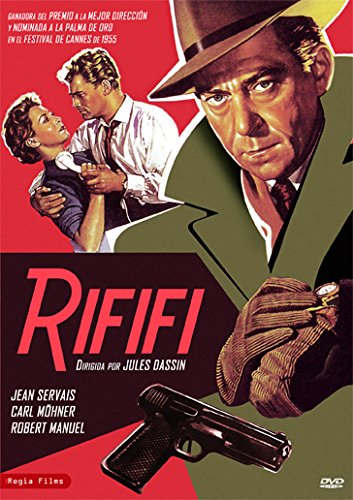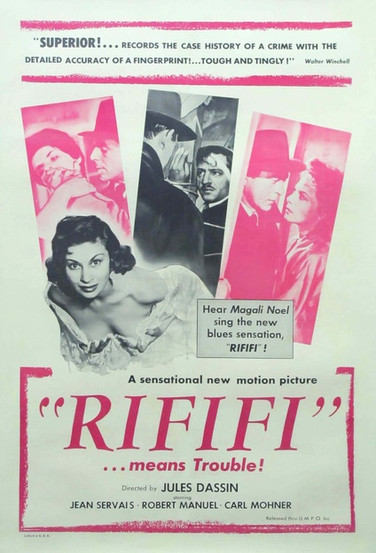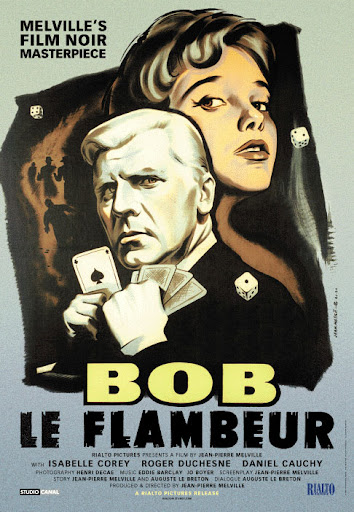"Rififi", "Bob Le Flambeur", "Big Deal On Madonna St", Dir: Dassin, Melville, Monicelli, '55,'56,'58
- Ravi Swami
- Jul 26, 2021
- 6 min read
As per usual, I watched these three films - all first-time viewings - out of chronological order, starting with Jean Pierre Melville's 1956 film, "Bob Le Flambeur" (Eng: "Bob The Gambler") but they all have something in common beyond similar themes of an aging criminal's last big job, which is that they are, like "Touchez Pas Au Grisbi", a hat tip to the American Film Noir genre.
The root of film noir and the pulp fiction that inspired it is America's Prohibition era coupled with the ravages of the Great Depression that drove many to a life of crime in order to make ends meet and parallels can be seen in the immediate post-war period in Europe as various criminal activities proliferated for much the same reasons.
So-called "career criminals" often became kingpins in various rackets that offered some a chance of escaping poverty.
Considered the gold standard of "heist" movies, Jules Dassin's 1955 film "Rififi" (the title derives from a North African tribe, the "Rifs", noted for their constant warring and consequent macho posturing, and was coined by Auguste Le Breton) pretty much established the template that spawned a whole slew of "Rififi-alike" films that used the term in their titles alongside some of the actors from the film, set in various European and other locations, such was its' success.
In more recent times contemporary film makers constantly reference it resulting in, for example, the first "Mission Impossible" film that features a complex break-in sequence along the lines of that seen in "Rififi", but with a high-tech angle.
Jules Dassin, who besides directing the film also appears in it as an Italian master safe-cracker, was actually an American forced out of a promising career in Hollywood following the Communist blacklist of the McCarthy Era. Europe, and specifically France, offered him a space to make films that brought an American sensibility and plots wedded to a neo-realist approach.
The plot revolves around "Tony "Le Stephanois"" (Jean Servais) who has served time following a jewel heist and is determined to stay out of trouble as a result. Looming poverty and a chance meeting with an old colleague, "Jo "le Suédois"" (Carl Möhner), who proposes he join him in assembling a crack team to rob a Parisian branch of Mappin & Webb, is the turning point that leads to the jewel heist that is the core of the plot.
It's quite a dark film and the Parisian criminal underworld through which Tony moves is cruel and violent and as Mado (Marie Sabouret), Tony's former girlfriend, points out, they will all be dead and deservedly so, following a vicious beating she receives at Tony's hands early in the film when he discovers that she is now the girlfriend of his hated rival, the nightclub owner, Pierre Grutter (Marcel Lupovici). The level of violence toward women in the film is echoed to some extent in scenes in the later 1962 Jean Pierre Melville film "Le Doulos" as a characteristic of the gritty and macho pulp crime fiction that inspired the film-noir genre.
The heist itself is meticulously planned and carried out and shot in a manner reminiscent of scenes in Jacques Becker's 1960 film "Le Trou", ie almost in real-time, which adds to the suspense and consequent relief when the criminals manage to outwit the police and escape with their haul, but this proves to be short-lived as Pierre Grutter and his gang get a tip-off on the identities of the perpetrators in the knowledge that there is a hefty reward for handing them over to the police and so ruthlessly hunt them down, with tragic consequences for all concerned.
The success and realism of "Rififi" led to both a series of real-life robberies and to it being banned or drastically edited in several countries on its' release, but that didn't prevent it from inspiring a number of equally classic films that followed, by prominent European New Wave directors.
Jean Pierre Melville's 1956 film "Bob Le Flambeur" follows closely on the heels of "Rififi" with an identical theme and to cash in on the surge in popularity for what promised to be "European Film Noir", besides which the French New Wave directors were eager to reference the American films that informed many of their own works.
The "Bob" of the title, played by Roger Duchesne, is an inveterate gambler who moves from gaming table to gaming table. A huge loss forces him to consider a proposal from a friend to rob the safe of a casino in Deauville but this will be no simple hit-and-run since the safe is heavily protected and robbing it will require careful planning.
However, the weak link in the escapade is one of the team, the croupier of the casino, whose wife gets wind of the plan and this throws a spanner in the works.
On Bob's heels is a police inspector who is disappointed that he has returned to crime after several years of being "clean" and at the films' conclusion following a shoot-out where several members of the team are killed by police, Bob is captured alive, the twist being that while at the casino waiting for the team to turn up at an appointed time, he has raked in a huge haul of money at the gaming tables, his luck having turned and the film ends with him telling the inspector that he now has enough money to hire a lawyer to get him off the hook.
It's an altogether more optimistic ending compared to that of "Rififi" even if we know that Bob is a hardened criminal, though a reformed one at the outset, and the film doesn't sugar coat the dealings of the underworld, which is depicted as violent - especially toward women - as in the earlier film.
It's a highly enjoyable film shot in stark contrasty monochrome with several hand-held shots of Paris by night that anticipate similar sequences from Louis Malle's "Elevator To The Gallows", a technique that became associated with the French New Wave movement and has influenced films since.
A detail I was unaware of until much later thanks to a friend on Facebook who actually knew Roger Duchesne is that the actor was a real-life criminal besides being an actor in several films from the late 1930's onwards, his career cut short following accusations that he had been a Nazi collaborator during the war, something that he strenuously denied in court. However, the damage had been done and he spent his later years in various occupations such as used car dealing etc, which is how my Facebook friend came across him.
He gives a fine, nuanced, performance in the film however and perhaps his real-life experiences give his performance an element of truth - in fact it appears that the plot itself was based on a real-life criminal escapade that Duchesne was involved in, in much the same way that Jacques Becker's film "Le Trou" is supposedly a recounting of actual events.
Mario Monicelli's 1956 film "I Solti Ignoti" (Eng: "Big Deal On Madonna St") is a classic for other reasons - clearly inspired by and spoofing Dassin's "Rififi" (it was even released as "Rufufu", as if that isn't enough of a hint - note the poster in the gallery) it's a broad comedy very much in the vein of the classic Ealing Comedies such as "The Lady Killers" or "The Lavender Hill Mob" (note the first poster image design that references posters for the Ealing Comedies in using caricatured portraits of the key actors) and as such is rooted in the "Commedia All'Italiana" genre.
The plot echoes "Rififi" in as a much as it is about a criminal, "Cosimo", (Memmo Carotenuto), who is banged up in prison after serving time for a previous robbery and who gets wind of a tempting "job" - the safe of a pawn shop - that could solve all his problems.
To get him out, his friends outside agree to find someone - Vittorio Gassman - to do time on his behalf with the promise of a pay-out if they succeed in cracking the safe of the pawn shop.
However, there being no honour among thieves, the plot goes awry with hilarious results in a plot peppered with some great character performances by Italian comedy actors like Toto and Marcello Mastroianni, once again showing his range as an actor in a role that echoes that of "Jo" from "Rififi" as a parent of a young child. In "Rififi" Jo is trying make ends meet and turns to a life of crime as the only way to pay to keep his family whereas in Monicelli's film, Mastroianni's character is a harrassed single parent of a toddler whose wife is serving time in a women's prison for selling illegal cigarettes.
The film also features an early supporting role by Claudia Cardinale, seen above in the last poster depicted as partially clothed for what seems to be a later rerelease since she doesn't appear in the film in that way at all, so clearly this was for commercial reasons.
The main joy of this film is the snappy dialogue and witty script and for a non-Italian speaker the nuances of the different regional Italian accents on display may be missed were it not for the excellent subtitling in the version that I watched, for free, on YouTube and now also available as part of a Marcello Mastroianni retrospective ("100 years of Marcello Mastroianni") on Criterion Channel's September line-up.
I would highly recommend all three films since they are all classics in their own way, referential and yet they succeed in being unique, innovative and distinctive.
"Rififi", Dir: Jules Dassin, 1955
Apple TV
"Bob Le Flambeur", Dir: Jean Pierre Melville, 1956
Criterion Channel
"Big Deal On Madonna Street", Dir: Mario Monicelli, 1958
YouTube Criterion Channel (Sept' 2024)















































Comments